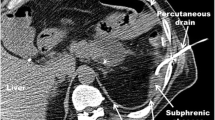Abstract
Introduction
Lung parenchymal abscesses represent an uncommon pathology with high mortality if untreated. Although most respond well to antibiotics, the optimal therapy for persistent abscesses is unknown. The purpose of this study was to review the outcomes of percutaneous lung parenchymal abscess catheter drainage after broad-spectrum antibiotic therapy failure and correlate with patient microbiologic samples.
Materials and Methods
Retrospective review of patients who underwent percutaneous lung abscess drainage at a tertiary hospital system from 2005 to 2015 was performed. In total, 19 procedures were identified on 16 different patients; six females and ten males. Mean patient age was 55 years (range 22–81). Median follow-up time was 7 months (range <1–78).
Results
Technical success was 100%. There was one major complication, a pneumothorax. Follow-up was until tube removal or death in 100% of patients. Catheters were removed with resolution of the abscess cavity in 58% (11/19) or with non-draining abscess cavities in 21% (4/19) for a clinical success rate of 79%. Blood cultures demonstrated no growth in all cases, while 21% (4/19) of sputum or bronchoscopic cultures demonstrated growth. In comparison, the specimens from initial catheter placement isolated a causative organism in 95% (18/19) of case (p < 0.0001).
Conclusion
In cases of persistent lung abscess after broad-spectrum antibiotics, percutaneous abscess drainage is highly sensitive for microbiologic sampling compared to sputum/bronchoscopic or blood cultures. Additionally, percutaneous drainage of lung parenchymal abscess cavities may promote resolution of the abscess with high rates of therapeutic success and low complications.


Similar content being viewed by others
References
Kuhajda I, Zarogoulidis K, Tsirgogianni K, Tsavlis D, Kioumis I, Kosmidis C, et al. Lung abscess—etiology, diagnostic and treatment options. Ann Transl Med. 2015;3:183.
Wali SO. An update on the drainage of pyogenic lung abscesses. Ann Thorac Med. 2012;7:3–7.
da Moreira JS, de Camargo JP, Felicetti JC, Goldenfun PR, Moreira ALS, da Porto NS. Lung abscess: analysis of 252 consecutive cases diagnosed between 1968 and 2004. J Bras Pneumol. 2006;32:136–43.
Kelogrigoris M, Tsagouli P, Stathopoulos K, Tsagaridou I, Thanos L. CT-guided percutaneous drainage of lung abscesses: review of 40 cases. J Bulg Soc Radiol. 2011;94:191–5.
Yen C-C, Tang R-B, Chen S-J, Chin T-W. Pediatric lung abscess: a retrospective review of 23 cases. J Microbiol Immunol Infect. 2004;37:45–9.
Yunus M. CT guided transthoracic catheter drainage of intrapulmonary abscess. J Pak Med Assoc. 2009;59:703–9.
Sziklavari Z, Ried M, Hofmann H-S. Vacuum-assisted closure therapy in the management of lung abscess. J Cardiothorac Surg. 2014;9:157.
Men S, Akhan O, Köroğlu M. Percutaneous drainage of abdominal abcess. Eur J Radiol. 2002;43:204–18.
Mueller PR, Berlin L. Complications of lung abscess aspiration and drainage. AJR Am J Roentgenol. 2002;178:1083–6.
Maskell NA, Medford A, Gleeson FV. Seldinger chest drain insertion: simpler but not necessarily safer. Thorax. 2010;65:5–6.
Horsley A, Jones L, White J, Henry M. Efficacy and complications of small-bore, wire-guided chest drains. Chest. 2006;130:1857–63.
Kajiwara K, Yamagami T, Ishikawa M, Yoshimatsu R, Baba Y, Nakamura Y, et al. CT fluoroscopy-guided percutaneous drainage: comparison of the one step and the Seldinger techniques. Minim Invasive Ther Allied Technol. 2016;26:1–6.
Cafarotti S, Dall’Armi V, Cusumano G, Margaritora S, Meacci E, Lococo F, et al. Small-bore wire-guided chest drains: safety, tolerability, and effectiveness in pneumothorax, malignant effusions, and pleural empyema. J Thorac Cardiovasc Surg. 2011;141:683–7.
Yang PC, Luh KT, Lee YC, Chang DB, Yu CJ, Wu HD, et al. Lung abscesses: US examination and US-guided transthoracic aspiration. Radiology. 1991;180:171–5.
Peña Griñan N, Muñoz Lucena F, Vargas Romero J, Alfageme Michavila I, Umbria Dominguez S, Florez AliaC. Yield of percutaneous needle lung aspiration in lung abscess. Chest. 1990;97:69–74.
Bartlett JG. Anaerobic bacterial infection of the lung. Anaerobe. 2012;18:235–9.
Alvarez-Lerma F. Modification of empiric antibiotic treatment in patients with pneumonia acquired in the intensive care unit. ICU-acquired pneumonia study group. Intensive Care Med. 1996;22:387–94.
Author information
Authors and Affiliations
Corresponding author
Ethics declarations
Conflict of interest
All authors declare that they have no conflicts of interest.
Rights and permissions
About this article
Cite this article
Duncan, C., Nadolski, G.J., Gade, T. et al. Understanding the Lung Abscess Microbiome: Outcomes of Percutaneous Lung Parenchymal Abscess Drainage with Microbiologic Correlation. Cardiovasc Intervent Radiol 40, 902–906 (2017). https://doi.org/10.1007/s00270-017-1623-3
Received:
Accepted:
Published:
Issue Date:
DOI: https://doi.org/10.1007/s00270-017-1623-3




